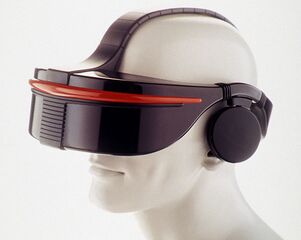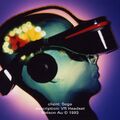Sega VR
From Sega Retro

|
| Sega VR |
|---|
| Manufacturer: Sega |
The Sega VR is an unreleased add-on for the Sega Mega Drive. While announced to much fanfare at time when Sega was dominating the home console market in much of the Western world, it was quietly cancelled around 1994/1995.
Contents
Hardware
The Sega VR unit was designed as an add-on for the Mega Drive, being based on an IDEO virtual reality headset (HMD) with LCD screens in the visor and stereo headphones. Inertial sensors in the headset allowed the system to track and react to the movements of the user's head - one of the first of its kind.
Unlike other headsets of the time, the Sega VR was designed to be lightweight and not hurt after prolonged wear.
The headset's head-tracking sensors monitor the player's head movements at a rate of 100 Hz (100 times per second). This ensures that the scene updates rapidly, in sync with the player's head movement, to provide the virtual-reality experience of being inside a game world. The headset also uses stereo sound, which enhances the virtual-reality experience. It also has stereoscopic 3D technology, giving 3-D depth to the visuals.[1]
History
Development
After a decade of rapid growth and development, the early 1990s saw computer graphics reach a stage in which large numbers of 3D polygons could be rendered on a screen in real-time. As these 3D "virtual worlds" expanded, so did the desire to create technology which could experience engaging with them first hand; so-called "virtual reality". While the term can be dated back to 1958, prior attempts at inserting the user into a virtual world were purely mechanical and far more primitive.
From a early 90s video game perspective, virtual reality was seen by many as the next step forward following the move into 3D graphics and gameplay, however numerous economical factors slowed the process, namely the equipment to render a believable 3D scene was very expensive, and means to interact with the virtual world had not yet been explored. As research and development costs rose, the virtual reality bubble burst, and the companies which invested were forced to cut their losses.
In the end, virtual reality in the home was considered unfeasible, and it would be the best part of two decades before another meaningful push in this area was made.
Both Sega and rivals Nintendo had dabbled in various forms of very basic virtual reality during the late 1980s and early 90s - the Sega Master System's 3D Glasses and the Nintendo Entertainment System's Power Glove showed promise, but ultimately failed to capture the public's imagination.
Sega VR was revealed to the public at Summer CES 1993 with a proposed price tag of around $200[2] (£130). It was originally scheduled to launch in December 1993, followed by a UK launch in 1994.[3] Four games were supposedly in development for the system, each using 16Mb cartridges that were to be bundled with the headset: Nuclear Rush, Iron Hammer, Matrix Runner and Outlaw Racing. Reports also suggest a port of the hit arcade racer Virtua Racing was also planned for the system.[4]
But the Summer CES showing was very low key, with screenings of a "ropey" prototype only occuring behind closed doors.[5] UK journalists were turned away as the system was not set for release in that region until at least the fourth quarter of 1994[5], however as it transpired, the US release would miss its Christmas 1993 launch window and be delayed until to August 1994[6].
The Independent on Sunday reported in 1993 that Sega's VR project could cause eye damage, which caught the attention of Sega's lawyers. The newspaper issued an apology on 3rd October, as the Sega VR was still in a prototype stage and not available on the market.[7] There have also been reports of testers developing headaches and motion sickness. Mark Pesce (the technology used in Sega VR is based on a Patent, which was licensed to Sega, for a Sourceless Orientation Sensor[8] invented by Ono-Sendai Corporation, a first-generation virtual reality startup, founded in 1991 by Mark Pesce, with the aim to create inexpensive, home-based networked VR systems, which back then could cost over a quarter million dollars[9]), who worked on the Sega VR project, claimed the Stanford Research Institute warned Sega of the 'hazards' of prolonged use.[10]
After its initial buzz, the Sega VR system was pulled from the schedules in 1994 and has not been seen since. Sega has claimed the project was stopped because, as the VR was so "real", users would try to move while wearing the headset and injure themselves, however the limited processing power of the system makes this claim less likely. In an October 1994 interview with Tom Kalinske, it was claimed a VR headset was still in the works, but that the Sega VR shown at Summer CES "didn't deliver the VR experience"[11]. Sega of America were confident they would be able to produce something for less than $225 USD for the Sega 32X or Sega Saturn[11], but neither materialised.
Legacy
Sega went on to other VR projects for use in arcades and a similar add-on was reported but never seen for the Sega Saturn. The project encouraged a brief flurry of other companies to offer VR products, though most had encountered similar concerns (for example, Nintendo's Virtual Boy is seen as a market failure).
Similar technology was seen in Sega's VR-1 simulators (released in 1994), although a more scaled-down arcade version, Dennou Senki Net Merc was not so well-received, with the flat-shaded graphics of the Sega Model 1 board being compared unfavourably to the Sega Model 2's textured-filtered graphics[12].
Despite never receiving an official release, the Sega VR was featured in the Spike Lee movie Clockers (with a game called "Gangsta") and promotional material for the system had been created, leading to speculation that working units were produced before the system was discontinued. The Sega VR can be seen in a 1992 American commercial for Alpha-Bits cereal.
The concept of head-tracking VR would not be be revisited again until the rise of motion controls in the 21st century, namely the 2012 announcement of the Oculus Rift, which cited Sega's headset as an influence.
Patents
Videos
Sega VR at 1993 CES
Alan Hunter Press Conference
Alpha-Bits and Sega VR
Photo gallery
Magazine articles
- Main article: Sega VR/Magazine articles.
References
- ↑ Sega Visions, "August/September 1993" (US; 1993-xx-xx), page 94
- ↑ Sega Force Mega, "August 1993" (UK; 1993-06-24), page 6
- ↑ Computer & Video Games, "August 1993" (UK; 1993-07-15), page 15
- ↑ File:EGM US PreviewGuide 1993.pdf, page 5
- ↑ 5.0 5.1 Sega Force Mega, "September 1993" (UK; 1993-07-22), page 9
- ↑ Sega Magazine, "March 1994" (UK; 1994-02-15), page 11
- ↑ Edge, "December 1993" (UK; 1993-10-28), page 13
- ↑ File:Patent US5526022.pdf, page 1
- ↑ https://medium.com/ghvr/tc-shanghai-2016-8ad6c097262d
- ↑ http://www.audioholics.com/news/editorials/warning-3d-video-hazardous-to-your-health
- ↑ 11.0 11.1 Electronic Gaming Monthly, "December 1994" (US; 1994-xx-xx), page 193
- ↑ Next Generation, "June 1995" (US; 1995-05-23), page 25
| Sega VR | |
|---|---|
| Topics | Technical specifications | Magazine articles | Promotional material | Ono-Sendai Corporation |
| Games | Iron Hammer | Matrix Runner | Nuclear Rush | Outlaw Racing |

